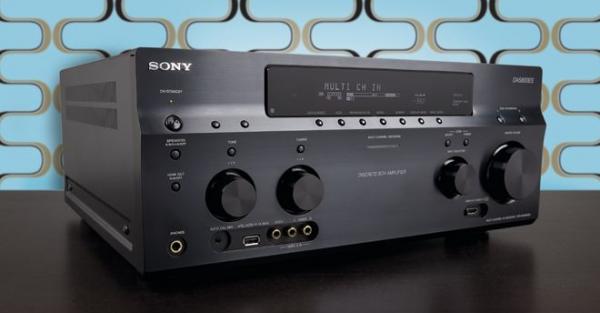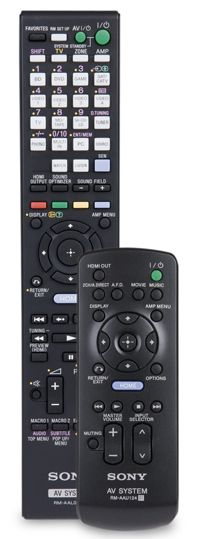Sony STR-DA5800ES review

The STR-DA5800ES is an AV receiver unlike any other. With it Sony has avoided the obvious – there’s no AirPlay or Bluetooth streaming – but pushed the envelope when it comes to leading-edge signal processing and usability. It’s remarkably forgiving of your living space but offers uncompromised audio quality. For many AV enthusiasts this will sound like very good news indeed.
The STR-DA5800ES takes its style cues directly from its predecessor, the STR-DA5700ES. It’s a chunky design, albeit not in the super-heavyweight class, distinguished by a stylised tiered fascia that’s aesthetically much too fussy.
The receiver is a 9.2-channel affair, rated at 120W per channel (into 8ohms). In addition to the standard seven-channel surround array, there are optional front height channels. Alternatively, you can bi-amp the front stereo pair.
Connectivity is outstanding. With no fewer than nine HDMI inputs (one front-facing), two HDMI outputs with a third HDMI Zone 2 feed, plus five legacy source inputs, you’ll not soon run out of ingress. Four of the HDMI inputs can display previews of connected components, aka InstaPrevue, while five inputs facilitate high-speed switching, aka Fast View. Sony has nominated two of the HDMI inputs (2 and 3) as optimal audio connections, ideal for movie playback and SACD performance. In repose, the receiver also offers HDMI passthrough. This means that signal sources connected to the AVR can be viewed without powering up the box; this proves to be invaluable when a set-top box is one of your prime sources, as it really doesn’t make sense to fire up the AVR for everything you watch.
As with the STR-DA5700ES, this new receiver has a built-in network switch. However, this time around, Sony’s engineering team has gone out of its way to reduce system noise, shutting down each of the LAN points individually when they’re not in use, thereby reducing the flow of redundant electrical current.
The STR-DA5800ES is more at home networked than any other AV receiver you can buy. Once online you can play your own content or take advantage of Sony’s catch-up and IPTV services. Unusually for an AVR, there’s more video content than audio on tap. You can choose from Video Unlimited, Demand 5, Sky News, LoveFilm, Mubi, Crackle, YouTube, DailyMotion and more, although, annoyingly, no BBC iPlayer. Audio-only diversions are largely limited to Sony’s Music Unlimited subscription service and internet radio. There’s no Spotify or Last.fm.
À la mode functionality includes 4K upscaling, which may or may not prove of use in the longer term, plus Ultra HD passthrough for those planning to acquire a 4K source of some description. Reflecting the booming interest in outboard DACs, the AVR also sports a USB Type B DAC input, compatible with 192kHz/24-bit audio.
Impressive usability The user front-end offered by the STR-DA5800ES is terrific, with easily navigated silos dubbed Watch, Listen, Favorites, Easy Automation (a four-scene macro), Sound Effects and Settings. Select Watch and you're greeted with hi-res graphics representing each of the inputs. It’s like navigating a Smart TV.
The user front-end offered by the STR-DA5800ES is terrific, with easily navigated silos dubbed Watch, Listen, Favorites, Easy Automation (a four-scene macro), Sound Effects and Settings. Select Watch and you're greeted with hi-res graphics representing each of the inputs. It’s like navigating a Smart TV.
The supplied D.C.A.C. EX auto-calibration system is ruthlessly efficient, making setup a doddle. The stereophonic calibration mic plugs into the front fascia and takes just 30 seconds to fine-tune speaker distance, level and phase. The results can be overlaid with the characteristics of the Sony engineering room in Shinagawa, left flat or further tweaked.
What’s particularly clever is that Sony applies considerable processing grunt to compensate for all those physical restrictions that affect real-world listeners – after all, few of us have a perfect listening room at our disposal. A centre speaker Lift Up function virtually raises the vocal height of the centre speaker, often positioned too low because of physical restraints. By shifting the apparent source of the centre speaker, dialogue intelligibility appears to improve. The scale of adjustment varies from 0-10.
No room for physical front height speakers? Then try this AVR’s Virtual Front High Speaker function instead, which psycho-acoustically adds cloudy atmospherics. This ambience is actually created out of the main stereo mix, and not any specific height information, but it’s surprisingly effective. The mode certainly relocated more chimps into my rafters during Caesar’s incarceration pen sequence from Rise of the Planet of the Apes. Virtual Speaker Relocation is available for all nine channels, allowing you to create a soundstage that would otherwise be impossible to obtain.
Inside the beastAt the heart of the STR-DA5800ES is the latest iteration of Sony’s Digital Cinema Sound audio processing technology, dubbed HD-D.C.S. We’ve heard some clunky DSP over the years, all purporting to recreate the acoustics of a movie theatre yet succeeding only in emulating the feel of a 1970s' grindhouse. But here, HD-D.C.S. proves to be a good deal more intriguing. Able to add subtle scale to the soundfield, Sony’s latest algorithms find plenty of room to work within the STR-DA5800ES’ nine-channel environment. HD-D.C.S. is one audio treatment even purists won’t find sucky.
Based on high-resolution acoustic data captured at the Cary Grant Theater dubbing stage on the Sony Pictures Culver City lot, HD-D.C.S. adds various levels of reflection and nuance which mimic the physical characteristics of that theatre. You can select from three flavours: Studio, Theatre and Dynamic. The former recreates the kind of reverb experienced with near-field mixing, and I found it particularly effective on Game of Thrones (a show which enjoys a particularly aggressive mix). The Theatre mode is rather more expansive, bringing a crisp dialogue to movies. Dynamic is altogether more overt and can be ruinous on any narration. The opening monologue from Transformers: Dark of the Moon sounded as if it was recorded by an Autobot skulking beneath my stairs.
Naturally there’s also a plethora of music modes. Of particular interest are a trio of concert hall treatments based on measurements taken in actual locations. The Berlin Philharmonic Hall mode is based on readings taken at the orchestra’s home base, while the Concertgebouw mode re-creates the slappier reflections of a huge plaster-walled hall found in Amsterdam. The Musikverein option emulates a wooden venue in Vienna. While I’ve never been a major advocate of venue treatments, they do provide an interesting way to shift two-channel sources into a convincing form of multichannel.
Build quality is exceptional. The AVR features a 'Metal Assist Horizontal FB' (Frame and Beam) chassis, which physically connects each side of the box and is designed to provide greater stability when handling excessive LFE. A metal strut runs across the bottom of the chassis lending additional reinforcement, so even A Good Day to Die Hard played at Reference Level shouldn't shake this puppy.
There's a cooling fan onboard, but it only comes on when absolutely required; Sony says that ‘natural air cooling’ keeps it ticking over. In my experience it never ran overly hot.

In full flight, the STR-DA5800ES proves massively exciting. It handles big theatrics with the ease of Patrick Stewart. The opening of J.J. Abrams' Star Trek reboot on Blu-ray is fast and visceral, with high-pitched pings and explosive LFE coming from every angle. There’s a fourth-generation wideband power plant at work here, and it delivers stellar transients. The receiver never rasps at high volume, leaving detail and intelligibility untarnished. As a high-octane multichannel movie machine this ES flagship is a blast.
Of course, you won’t always have your pedal to the metal. Step forward the Sound Optimizer, which combats the reduced slam that comes when you need to drop volume (both bass and high frequencies are difficult to perceive at low levels). The Sound Optimizer rather cleverly reinstates the balance found at higher volume with a frequency weighting curve. When engaged, a definite sense of scale is returned to the Star Trek universe, even when it’s not boldly going at full tilt.
File compatibility on this AVR is excellent, both from USB media and across a network. I successfully played back AAC, M4A, MP3 and WMA, plus WAV and FLAC files up to 192kHz/24-bit 5.1. While there’s no support at present for DSD, the fast-rising high-quality download format, Sony promises that this will come at some point during the Summer. The AVR can be firmware updated over a network connection. Streaming video support (a rarity within the AVR world) covers key codecs and containers such as AVI, MKV, MOV and MPEG.
Naturally the Sony is compatible with all the usual audio codecs, plus DTS Neo: X and Dolby Pro-Logic IIz, but it doesn’t proffer any form of THX post-processing. Still, there’s enough flexibility in the setup options to effectively recreate some of post-processing characteristics that THX offers (small speakers, 80Hz crossover, centre channel EQ etc) should old-schoolers want to experiment.
Inspired updateThe STR-DA5800ES is an inspired update on last year’s STR-DA5700ES. Almost miraculously, Sony has wedged in two more channels of amplification, bolstered build quality and improved audio processing. The result is a receiver that’s inventive, invigorating and flat-out exciting to listen to. What Sony has achieved with virtual channel placement borders on the revolutionary, so for all of us without the space to implement an idealized home cinema, this is worth the price of admission alone. A stunning performer.
HCC VERDICT
 Sony STR-DA5800ES
Sony STR-DA5800ES
Price: £2,000 Approx
www.sony.co.uk
Highs: Powerful, dynamic multichannel delivery; advanced audio processing modes; integrated network switch; great user interface, streaming video content support
Lows: No Airplay; no Spotify; no THX post-processing; no 11-channel pre-out
Performance: 5/5
Design: 4/5
Features: 4.5/5
Overall: 5/5
 |
Home Cinema Choice #351 is on sale now, featuring: Samsung S95D flagship OLED TV; Ascendo loudspeakers; Pioneer VSA-LX805 AV receiver; UST projector roundup; 2024’s summer movies; Conan 4K; and more
|






















































